Thursday April 7, 2022
Today was mostly a driving day following Route 50 274 miles (441 km) east to Dodge City, Kansas. After the spectacular scenery of the Rockies driving was relatively dull, straight roads with a few undulations, but it needed my full attention because of dangerous cross-winds.
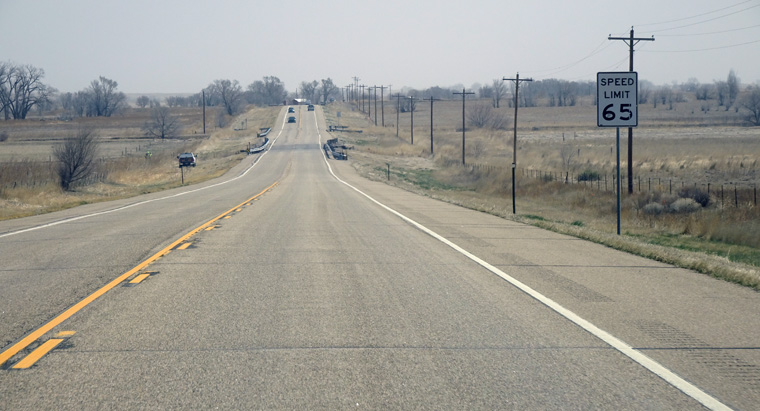 An atypical road scene from today – there was a hill.
An atypical road scene from today – there was a hill.
The wind was incredibly strong along the whole route but particularly for the last 100 miles where debris and vegetation were blowing across the road – and I don’t mean on the road but about three feet above it, I found it very hard to walk back to the car from a rest stop and a bus-sized RV had been blown over onto its side along a straight stretch of road.
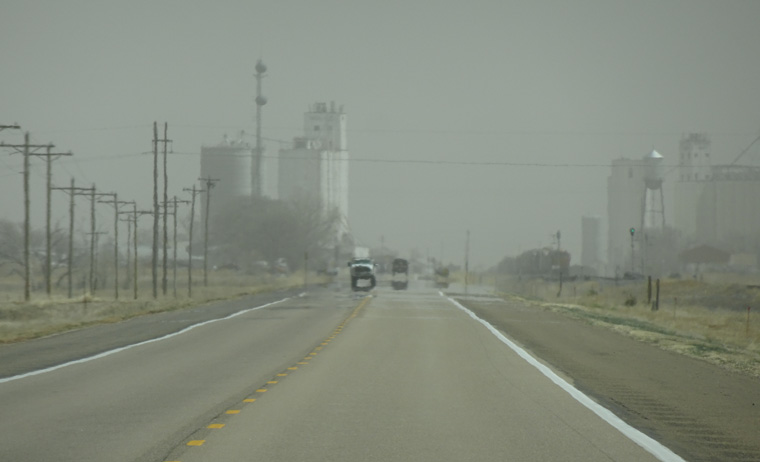 The wind was picking up so much dust and dirt that it appeared as if you were constantly driving towards low lying smoke from a fire. This spring has been wet but it is easy to imagine how the dust bowls of the 30s would have formed during a drought.
The wind was picking up so much dust and dirt that it appeared as if you were constantly driving towards low lying smoke from a fire. This spring has been wet but it is easy to imagine how the dust bowls of the 30s would have formed during a drought.
Route 50 follows the path of two trails used by pioneers in the opening up of the west, the Santa Fe Trail and the Pony Express Trail, so there are many historical sites, such as forts and battlefields, along the way. Today, however, I visited a more recent historical site that has just been recognized as such, the Amache National Historic Site. This was the location of one of the Japanese internment camps during the Second World War. The legislation to award the Historic Site designation was just signed into law by President Biden on March 18th and the National Park Service will gradually assume its operation over the next few years.
Shortly after the attack on Pearl Harbor in 1942 President Franklin D. Roosevelt issued an executive order that led to the incarceration of almost 120,000 residents of Japanese descent living in western coastal states. They were given a few days to dispose of their property, anything left was seized by the government and then they were transferred to “relocation centers” inland. Amache was one of these centers near Granada, Colorado and, with a population of over 10,000, (7,300 Japanese plus employees/guards) became the 10th largest community in Colorado while it was open between August, 1942 and October 1945.
The site is just 1 square mile and used to contain about 550 buildings but most were simple wooden barracks with no insulation and little heating that were hastily constructed by the army. They were all demolished after the war but you can still see the foundations today. The site is currently run by the local historical preservation society who have reconstructed a few important structures using plans and materials of the time.
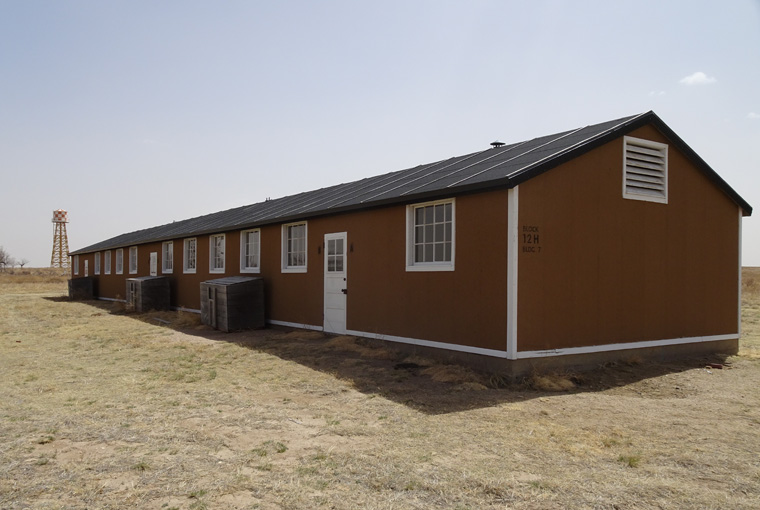 Reconstruction of a typical barrack. The buildings were not open.
Reconstruction of a typical barrack. The buildings were not open.
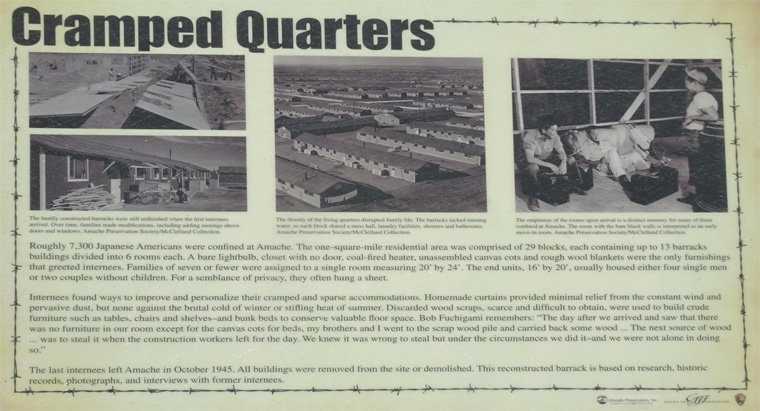 Information about Amache living quarters. Click the image for a full sized, readable, image.
Information about Amache living quarters. Click the image for a full sized, readable, image.
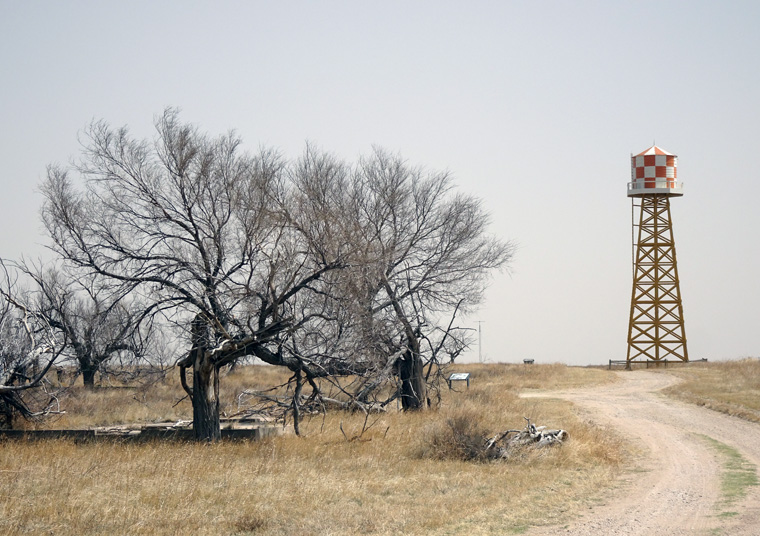 The water tower has been rebuilt. Four wells were drilled to keep the 200,000 gallon tank full and the water was then gravity fed to the camp.
The water tower has been rebuilt. Four wells were drilled to keep the 200,000 gallon tank full and the water was then gravity fed to the camp.
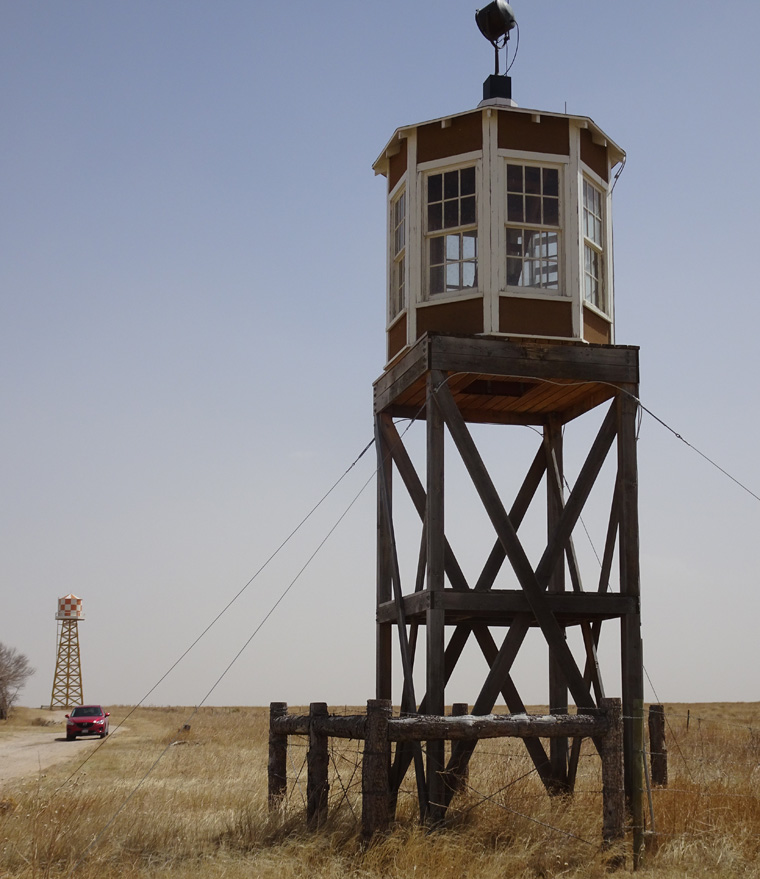 A reconstructed guard tower. There were ten around the camp.
A reconstructed guard tower. There were ten around the camp.
I was the only visitor and the wind was so strong that, within 30 yards, I decided to drive instead of walk around the site. Even so, at each stop, I thought “this is a miserable experience”. The camp is at an altitude of 3,500 feet (1,062 m) and it was very cold as I struggled to hold the camera still. Just think what it must have been like for the internees – particularly in the winter.
This short video gives an idea of the strength of the wind at the entrance to the camp.
Although here was not a lot to see it was interesting to be in the environment and read about conditions. I’m sure National Park Service investment will make it a great educational experience in the future.

So much fun to learn history like this. Drive safely, Steve!!
Really interesting to read about Amache – reminds me of a fiction book by Guterson called “Snow Falling On Cedars”, which, though set in 1954, refers back to he Japanese internment and its consequences for the protagonists.
Your video really demonstrated the wind there – no wonder you were the only visitor.
I enjoy visiting places like Amache. Being there really makes you think about the events, rather than just learning about them from a documentary or website.
I think this place will linger in your memory more than others.
You are correct. I will probably follow the progress of the National Historical Site implementation.
I can’t imagine how the interned Japanese must have felt after living here in the US for generations. Individual racism is one thing , though unpardonable, but state sponsored racism is so frightening. FDR like LBJ has to be revisited again and again. So glad to “see” the US through your eyes.
It was definitely a moving visit and I am pleased that it will be expanded to become an educational site by the Park Service. The racial aspects were very strong. Not only were no Japanese Americans found to be disloyal during the war but the officials near these camps did not want the Japanese in their neighborhood and demanded they be locked away before accepting them. Finally, under Reagan, the US admitted the racism and offered $20,000 reparations to all internees still alive.